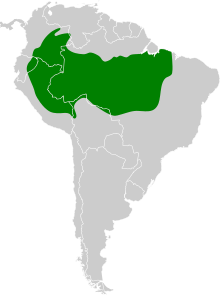Amazonian streaked antwren
| Amazonian streaked antwren | |
|---|---|

| |
| Female at Apiacás, Mato Grosso state, Brazil | |
| Scientific classification | |
| Domain: | Eukaryota |
| Kingdom: | Animalia |
| Phylum: | Chordata |
| Class: | Aves |
| Order: | Passeriformes |
| Family: | Thamnophilidae |
| Genus: | Myrmotherula |
| Species: | M. multostriata
|
| Binomial name | |
| Myrmotherula multostriata Sclater, PL, 1858
| |

| |
The Amazonian streaked antwren (Myrmotherula multostriata) is a species of
Taxonomy and systematics
The Amazonian streaked antwren was
Description
The Amazonian streaked antwren is 9 to 10 cm (3.5 to 3.9 in) long and weighs 7.5 to 9 g (0.26 to 0.32 oz). It is a smallish bird with a tiny tail. Adult males have a black and white streaked face. Their crown, back, and rump are black with white streaks. They have a large white patch between the shoulders. Their tail is black with white edges and tips to the feathers. Their wings are black with white tips on the
Distribution and habitat
The Amazonian streaked antwren is found locally in eastern Colombia and southern Venezuela. From there its range extends south and east through eastern Ecuador and eastern Peru into northern Bolivia and central Brazil to Maranhão and Tocantins in the east and Mato Grosso in the south. There is also an apparently isolated population in Brazil's Mato Grosso do Sul. It occurs almost entirely south of the Amazon River except in the lower reaches of the Rio Negro basin, a northern tributary. It inhabits the understorey and mid-storey of lowland evergreen forest (primarily várzea and igapó) and shrubby secondary forest. It occurs almost entirely near water, in thickets and vine tangles along rivers, streams, and oxbow lakes. In elevation it ranges from sea level to about 550 m (1,800 ft) but only to about 300 m (1,000 ft) in Colombia and Ecuador.[9][10][11][12]
Behavior
Movement
The Amazonian streaked antwren is believed to be a year-round resident throughout its range.[9]
Feeding
The Amazonian streaked antwren feeds on
Breeding
The Amazonian streaked antwren nests in Brazil between July and December; there are nesting records from Columbia in July and from Bolivia in June. Its nest is a cup or pouch of plant filaments and green moss with dried leaves on the outside, typically suspended from a fork about 0.3 to 3 m (1 to 10 ft) above water or the bank of a water feature. The clutch size is two eggs. Both parents incubate during the day and apparently only the female at night. The incubation period, time to fledging, and other details of parental care are not known.[9]
Vocalization
The Amazonian streaked antwren's song is a "short, musical, at start slightly rising rattle"[10] that has been written as "pur-pur-peé-peé-peé-pur"[11]. Its calls include "an evenly pitched dry trill 'dr-r-r-r-r-r' "[11], a " 'chee-pu' contact call"[11], and "a flat complaining note[9].
Status
The
References
- ^ . Retrieved 7 February 2024.
- ^ Rasmussen, Pamela, eds. (January 2024). "Antbirds". IOC World Bird List. v 14.1. Retrieved January 4, 2024.
- ^ Remsen, J. V., Jr., J. I. Areta, E. Bonaccorso, S. Claramunt, G. Del-Rio, A. Jaramillo, D. F. Lane, M. B. Robbins, F. G. Stiles, and K. J. Zimmer. Version 26 November 2023. Species Lists of Birds for South American Countries and Territories. https://www.museum.lsu.edu/~Remsen/SACCCountryLists.htm retrieved November 27, 2023
- .
- ^ Isler, M.L., Isler, P.R. and Whitney, B.M. (1999). Species limits in antbirds (Passeriformes: Thamnophilidae): the Myrmotherula surinamensis complex. Auk 116(1): 83–96.
- ^ Remsen, J. V., Jr., J. I. Areta, E. Bonaccorso, S. Claramunt, G. Del-Rio, A. Jaramillo, D. F. Lane, M. B. Robbins, F. G. Stiles, and K. J. Zimmer. Version 26 November 2023. A classification of the bird species of South America. American Ornithological Society. https://www.museum.lsu.edu/~Remsen/SACCBaseline.htm retrieved November 27, 2023
- ^ Check-list of North American Birds (7th ed.). Washington, D.C.: American Ornithologists' Union. 1998. p. 364.
- ^ Richard C. Banks, Carla Cicero, Jon L. Dunn, Andrew W. Kratter, Pamela C. Rasmussen, J. V. Remsen, Jr., James D. Rising, and Douglas F. Stotz. "Forty-second supplement to the American Ornithologist's Union Check-list of North American Birds". The Auk 2000, vol. 117:847-858 retrieved February 7, 2024
- ^ a b c d e f g h i Zimmer, K. and M.L. Isler (2020). Amazonian Streaked-Antwren (Myrmotherula multostriata), version 1.0. In Birds of the World (J. del Hoyo, A. Elliott, J. Sargatal, D. A. Christie, and E. de Juana, Editors). Cornell Lab of Ornithology, Ithaca, NY, USA. https://doi.org/10.2173/bow.amasta1.01 retrieved February 7, 2024
- ^ ISBN 978-0-19-530155-7.
- ^ ISBN 978-0-8014-8721-7.
- ^ ISBN 978-0-9827615-0-2.
Further reading
- Cadena, C.D.; Londoño, G.A.; Parra, J.L. (2000). "Nesting records of five antbird species from the Colombian Amazon". Wilson Bulletin. 112 (3): 313–317. S2CID 84421213.
- Ridgely, Robert S.; Tudor, Guy (2009). Field Guide to the Songbirds of South America: The Passerines. University of Texas Press. p. 141. ISBN 978-0-292-71748-0.
![]() Data related to Myrmotherula multostriata at Wikispecies
Data related to Myrmotherula multostriata at Wikispecies


